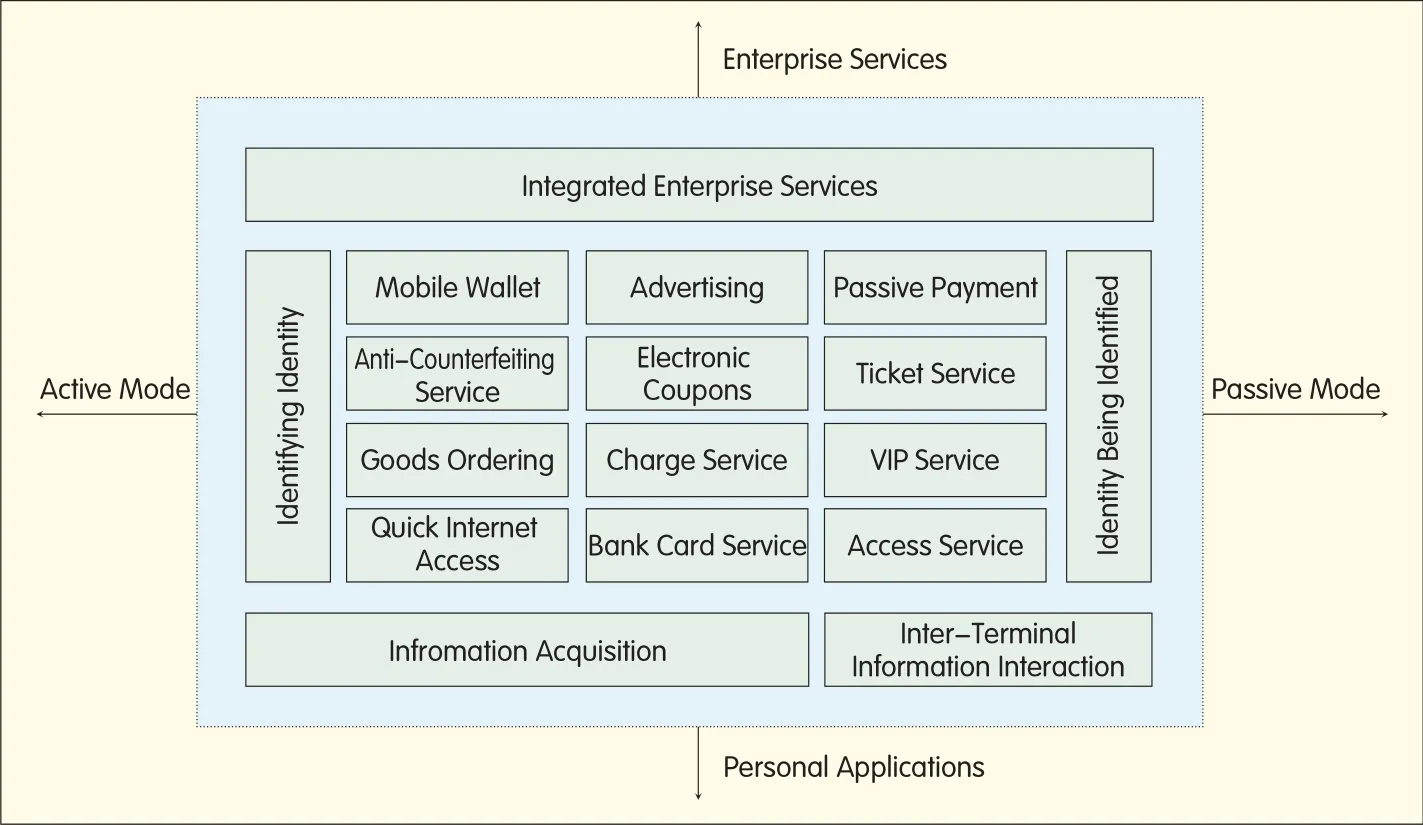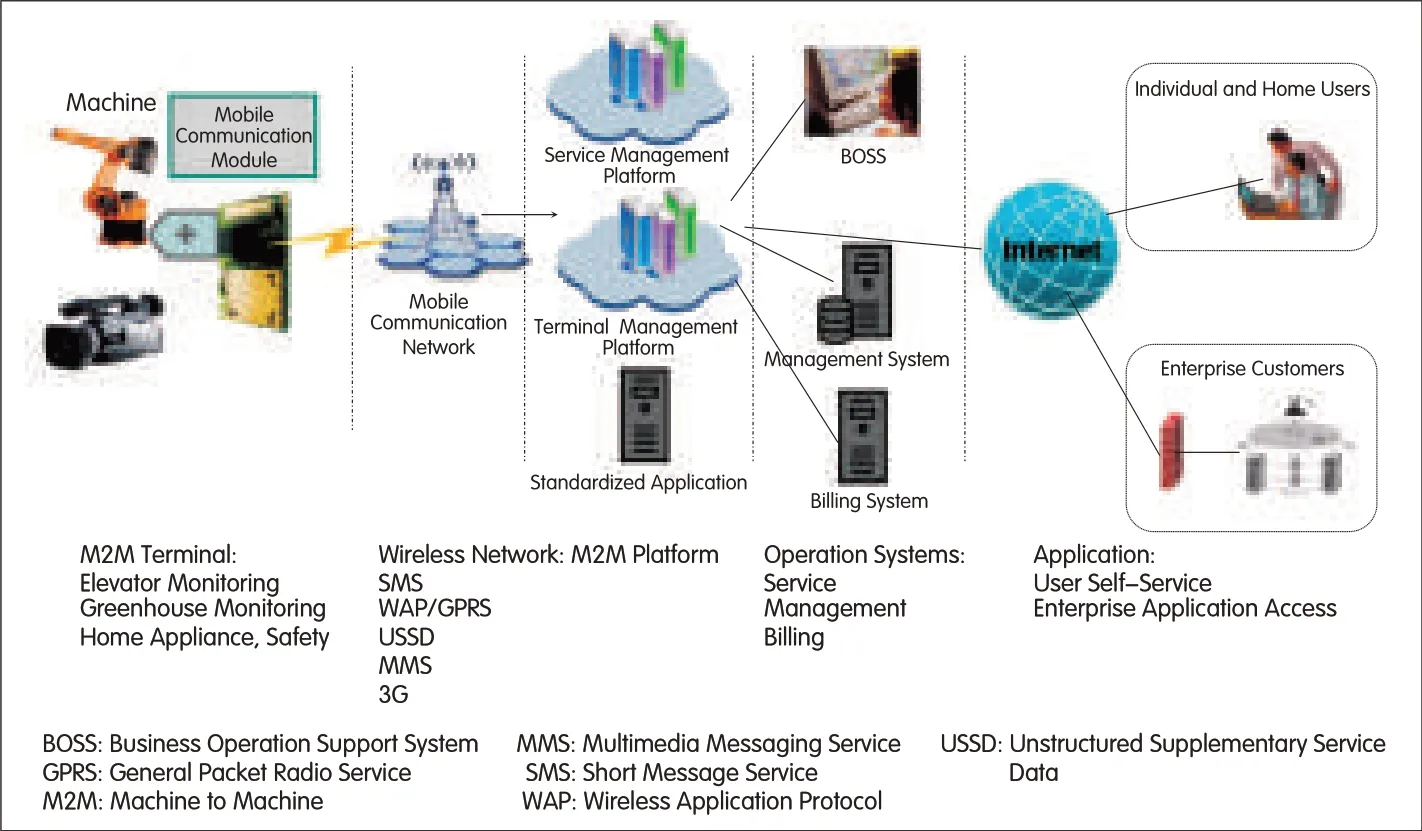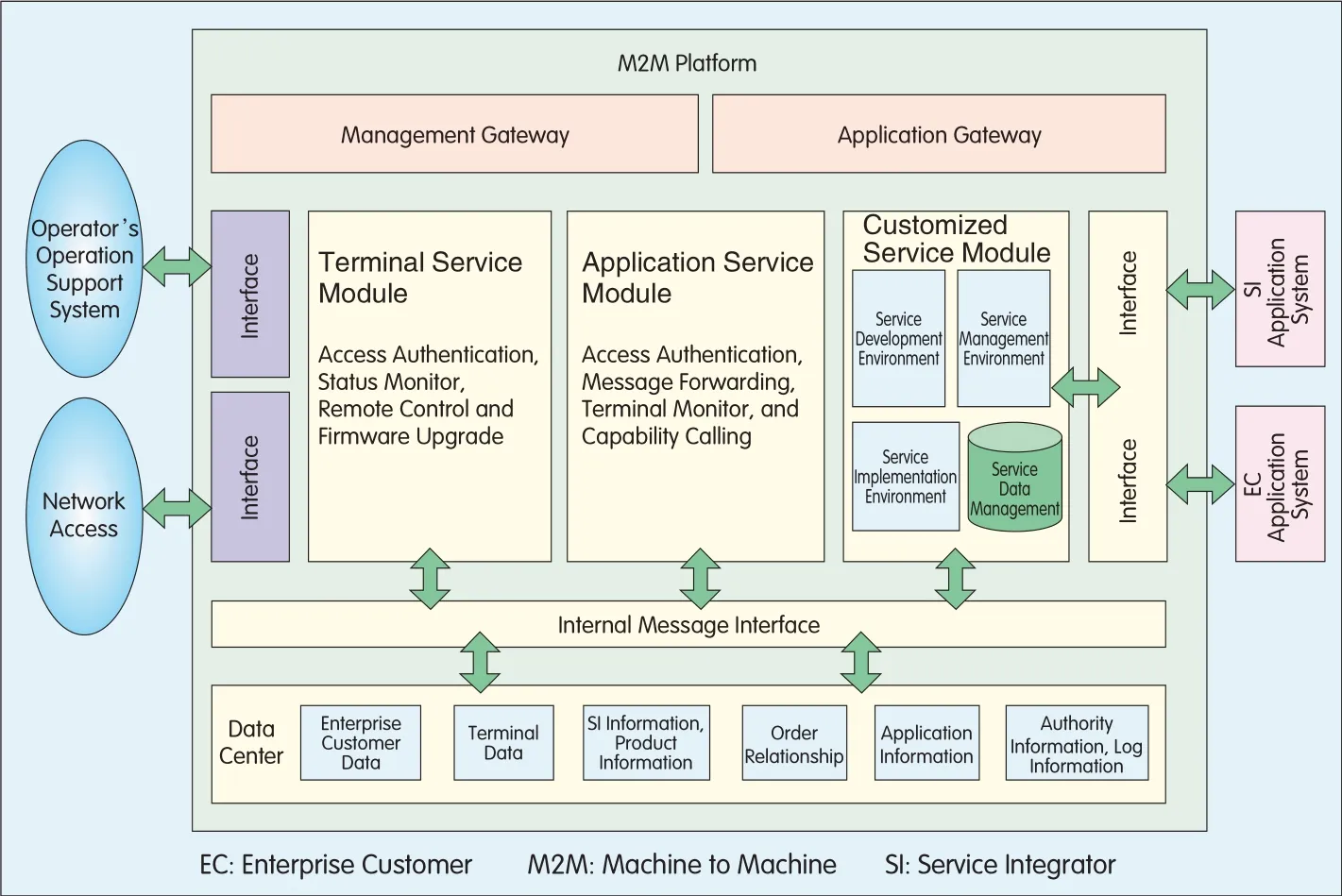Services and Key Technologies of the Internet of Things
Xing Xiaojiang,Wang Jianli,LiMingdong
(ZTE Corporation,Shenzhen 518004,P.R.China)
Abstract:This article introduces the services and development of the Internet of Things,and analyzes the driving forces and obstacles behind such development.Looking at application types and the different development stages of the Internet of Things,this article categorizes its services into four types:identity related services,information aggregation services,collaborative-aware services,and ubiquitous services.For the first two types of services,applications and system framework are discussed;for the last two types,development trends are discussed.Services provided by the Internet of Things will gradually be integrated into human life and society;with the development of the Internet of Things,applications will evolve from relatively simple identity-related and information aggregation-related applications,to collaboratively-aware,and finally ubiquitous applications.It will then be possible for the Internet of Things to be fully integrated with Internet and telecommunications networks.
T he concept“Internet of Things”was coined by Kevin Ashton of Massachusetts Institute of Technology(MIT)in 1999,and is defined as follows:all things are connected to the Internet via sensing devices such as Radio Frequency Identification(RFID)to achieve intelligent identification and management.Early in 1995,the book The Power to Predict[1]first described application scenarios of the Internet of Things.
In recent times,the Internet of Things has developed rapidly and globally due to increasing government and enterprise investment in projects in regions such as the USA,Europe,Japan,and South Korea.IBM’s Smarter Planet initiative will see an investment of 3 million dollars made in smart grid and digital healthcare projects.The EU has proposed an i2010 policy framework that aims to enhance economic efficiency and promote the development of Information and Communication Technologies(ICT)through widespread use of these technologies.In Japan,the i-Japan strategy is based on E-Japan and U-Japan.South Korea has also proposed a new project for the Internet of Things.In China,Prime Minister Wen Jiabo presented the concept of“Experiencing China”in August 2009.Driven by the Chinese Government,the Internet of Things industry has developed rapidly in China.
1.1 Driving Forces for Development of the Internet of Things
First,the development of the Internet of Things conforms to the trend of using information technologies to better serve society.On the one hand,modern society suffers development bottlenecks in the fields of energy,transport,logistics and financing.On the other,people have direct demands in health,and medical treatment and services.With a generalbelief that information technologies make for smarter terminals,wider networks,and better services than other technologies,they are naturally chosen to solve problems encountered in socialand economic development as well as to enhance standards of living.
Second,the Internet of Things is regarded as a new source of economic growth by many governments.The Information Superhighway Plan implemented by the Clinton administration brought 10 years of rapid economic development to the USA.Now,the Obama administration has put forward“Smarter Earth,”which probably has relations with the Information Superhighway Plan.In China,the Internet of Things is regarded as the practice of using information technologies to promote industrialization.In regions such as Europe,Japan,and South Korea,government plays an important role in Internet of Things planning.
1 Development of the Internet of Things
Third,with its businesses reaching saturation point,the telecom industry also regards the Internet of Things as a new breakthrough.In many European countries,mobile phone penetration rate has reached 100%.As a result,person-to-thing and thing-to-thing communication has been placed high on the agenda.The Internet of Things therefore represents a new stage in the development of the telecom industry.
1.2 Factors Affecting the Development of the Internet of Things
Despite these strong driving forces,the Internet of Things faces challenges.
First,inter-industry barriers are an important factor affecting the development of the Internet of Things.Currently,telecom service providers are the main promoters of the Internet of Things,and have made(or are making)ambitious plans for its development.However,there are technical barriers among industries,and different industries have their own industry chains,which are sometimes difficult to penetrate.
Second,several technological issues are difficult to overcome.Vast differences in applications make it difficult to work out a uniform service provision platform.Terminals and services vary dramatically in relation to industries and applications.
Third,the question stillremains whether the scale of the Internet of Things industry can support the entire industry chain.At present,interest from industries that may benefit from Internet of Things service is far from strong.
2 Services of the Internet of Things
There are a large number of applications that can be included as Internet of Things services,and these can be classified according to different criteria.According to technical features,Internet of Things services can be divided into 4 types:identity-related services[2],information aggregation services,collaborative-aware services,and ubiquitous services[3].
It is generally agreed that an inevitable trend for the Internet of Things will be its development from information aggregation to collaborative awareness and ubiquitous convergence,and that not allservices of the Internet of Things will develop to the stage of ubiquitous convergence.Many applications and services only require information aggregation,and are not intended for ubiquitous convergence as the information is closed,confidential,and applicable only to a small group.

▲Figure 1.Applications of identity-related services.
2.1 Identity-Related Services
Identity-related services adopt identity technologies such as RFID,two-dimensional code,and barcode.Figure 1 lists some identity-related services.
According to the identification mode of the terminal,identity-related services can be divided into two categories:active and passive.They can also be classified by served objects(enterprise or individual):personal applications or enterprise services.
The implementation of different applications may vary.Figure 2 illustrates the basic principle of tag-based information acquisition services.The general procedure for such services is as follows:first,an RFIDtag is attached to a thing.Then,a read device accesses the information in the RFID tag(including the identity information of the thing),and makes a request to the name resolution server of the Internet of Things.In this way,it may obtain the Uniform Resource Identifier(URI)of the thing.Finally,the read device obtains further information from the URI.
2.2 Information Aggregation Services
With such services,a terminal collects and processes data,and reports it via the communication network to the platform.The platform further processes the data and implements unified management of the terminals,data,applications,and services as well as third parties.Specific service applications include automatic meter reading,elevator management,logistics,and traffic management.
Figure 3 illustrates the framework of information aggregation services[4].In the Figure,the entire system is made up of Machine-to-Machine(M2M)terminals,a communication network,platforms,applications,and operation systems.The mobile communication network acts as an information transmission carrier,transmitting data in several ways.In fact,a fixed network can also be used as the data transmission channel.
Access gateway devices and application gateway devices can be added to the framework in Figure 3 in order to meet the demands of different networks,and to enable more terminals to access or provide services to enterprise customers.

▲Figure 2.Principle of tag-based information acquisition services.

▲Figure 3.Information aggregation services.
The access gateway device supports aggregation of terminals,and supports different networks,especially Network Address Translation(NAT)traversal.
The application gateway device provides enterprises with services or service interfaces by means of a gateway similar to an SMSgateway device.
Figure 4 shows a detailed function platform and its functions[4].
2.3 Collaborative-Aware Services
The development of the Internet of Things should bring about the delivery of more important and complicated services.Such services often require terminal-to-terminal and terminal-to-person communication.Moreover,these communication capabilities impose higher requirements on reliability and delay,and require terminals to be smarter.Only in this way,can collaborative processing be done.
To date,scenarios,demands,framework and communication protocols of such services have not been studied in depth.But in the long term,collaborative-aware services will be a trend in the development of the Internet of Things.
2.4 Ubiquitous Services

▲Figure 4.Information aggregation service platform and its functions.
Characterized by omnipresence,all-inclusiveness,and omnipotency,ubiquitous services aim to deliver smooth communication anytime,anywhere,for anybody,and for everything.They are the acme of communication services,pursued by human society.
It is unknown whether future ubiquitous services will use the Internet as their carrier,but it would represent a significant leap in the development of the Internet of Things,and an important development stage of Internet.Integration of the information of real-world things into the Internet would enable the sharing of things by more users through the Internet.In manageable and controllable telecom networks,things willbe included in the unified management system of the network to support thing-to-person and thing-to-thing communication(as wellas wide-range information sharing).Hence,the convergence of telecom networks and the Internet of Things is also an important trend.
So far,little research has been carried out into the research of ubiquitous services from the perspective of telecom networks.In September 2009,the Telecommunication Standardization Sector of the International Telecommunication Union(ITU-T)released the draft recommendation Y.2002(Y.NGN-UbiNet)[5],which outlines ubiquitous networks and their visions.
“5C+5Any”are key features of ubiquitous networks.5Cstands for convergence,content,computation,communication,and connection.5Any represents anytime,anywhere,any service,any network,and any object.
The ubiquitous network is generally defined as a fully connected,reliable,and intelligent network at the sublayer,and containing integrated content technology,micro technology,and bio-technology.Its communication services are extended into fields such as education,intelligent building,supply chain,health care,everyday life,disaster management,safety service,and transport to provide people with better services.The ultimate objective of ubiquitous networks is to allow people to enjoy convenience in information and communication,to better serve their lives,and even to change their lives.
3 Key Technologies for the Internet of Things
The above discussion shows that implementation of services in the Internet of Things mainly involves the key technologies of sensor,sensor network,sensor network-related communication,communication network,the Internet of Things platform,and integrated technologies.
The sensor is used to collect information in the Internet of Things;it is the basic part that senses the real world,and offers services and applications.However,due to the diversity of sensors(there are temperature,pressure,speed,humidity,height,video,image,and location sensors),information interfaces provided by these sensors vary widely.
This is the greatest challenge for mass production of Internet of Things terminals.
Much research has already been conducted into sensor networks,and a complete set of specifications have been made for the physical layer,link layer,and network layer.But sensor networks have not been put into application on a large scale[6].Typical sensor network-related communication technologies include Bluetooth,Infrared Data Association(IrDA),Wireless Fidelity(Wi-Fi),Zig Bee,RFID,Ultra-Wide Band(UWB),Near Filed Communication(NFC),and WirelessHart.Sensor networks will evolve to next generation IPnetworks(e.g.IPv6 networks),and sensor terminals will tend to become smarter.The intelligence of a sensor network is mainly reflected in its IPtechnology,low power consumption,small size,bidirectionaltransfer of information,and non-manual maintenance.
Communication networks provide the data transmission channel for the Internet of Things.Current research into communication networks focuses on how to enhance existing networks to meet the service requirements of the Internet of Things(e.g.low data rate,low mobility).
The Internet of Things platform works with terminals as well as exiting networks and systems to provide the capabilities to various applications.In terms of network architecture,a unified service platform that is suitable for applications of multiple industries is required to support cross-sector,unified information services.In particular,when the Internet of Things develops into the collaborative-aware or even ubiquitous service stages,more effective network framework,name address,routing,and communication protocols have to be worked out.
4 Conclusion
The Internet of Things is an inevitable result of social progress and it has bright prospects.It will,however,encounter many challenges—both technicaland industry-chain related—in its path of development.To overcome these challenges,focus will need to be given to Internet of Things’business model and key technologies simultaneously.

